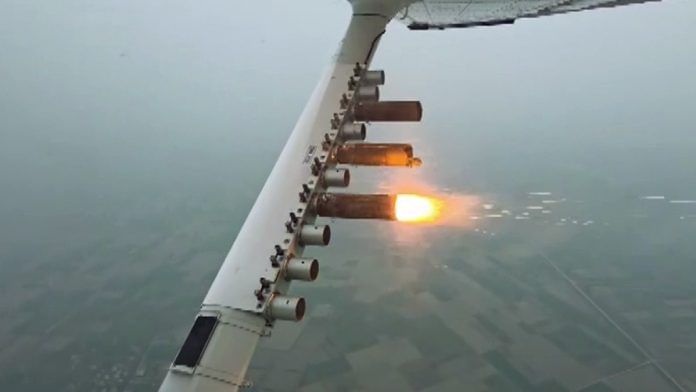New Delhi: The Delhi government Tuesday declared ‘success’ with the second round of cloud seeding trials conducted in the capital, though they might not necessarily lead to rainfall or improvement in Delhi’s AQI, which has remained in the ‘poor and very poor category’ over the past three weeks.
Around 1:30 pm Tuesday, a Cessna aircraft from IIT Kanpur sprinkled silver iodide mixture over clouds over Northwest Delhi’s Burari, Mayur Vihar and Karol Bagh to induce rainfall and clear the air. The exercise was carried out a second time over the same areas between 3:30 pm to 4:15 pm.
However, the IMD confirmed that there is no forecast of rain-bearing clouds or rainfall over Delhi for the next week. Sources in the Delhi government also confirmed that no rain had been recorded yet in areas where the cloud seeding trials were conducted Tuesday.
“The IIT Kanpur team said that it could take anytime between 15 minutes to four hours for rainfall to occur after seeding,” said Manjinder Singh Sirsa, Delhi Environment Minister, in a press statement. “But it won’t be a lot of rain since the clouds have low humidity.”

This was the round of second cloud seeding trials conducted in Delhi, following the first on the night of 23 October. But because of minimal clouds and moisture, it did not rain even then. The Delhi government in September entered into an Memorandum of Understanding (MoU) with IIT Kanpur for five trials to be conducted at a cost of Rs 3 crore.
Now, Sirsa has announced that the Delhi government, along with IIT Kanpur, plans to conduct 9-10 more trials in the next few days, whenever weather conditions permit.
The IMD predicts partly cloudy skies and no rainfall in the next week.
Cloud seeding is a process by which materials like silver iodide or calcium chloride are injected into rain-bearing clouds to speed up the process of rain formation. They have been used in other countries and earlier in India, too, for increasing or inducing rainfall during periods of drought or in rain-shadow areas. Previously in India, the Indian Institute of Tropical Meteorology in Pune conducted cloud seeding experiments in Maharashtra’s Solapur in 2018 and 2019, to increase rainfall. According to scientist Thara Prabhakaran, who was involved with the experiment, it took two years to finally achieve results, with an average increase of 18 percent in rainfall due to cloud seeding.
“It is not easy to do cloud seeding because there’s inherent variability in each cloud. It depends on the weather, the moisture, the size of the clouds, the origin of the clouds. We did over 200 different flights and trials to come to basic understanding,” she told ThePrint. “If you’re investing in cloud seeding, you should be able to prove the rainfall is actually because of seeding, robustly with experiments. It can’t happen with one or two trials.”
In the statement issued Tuesday, Sirsa explained that the Delhi government wants to “do trials and gather information on what kind of rainfall can occur, and how it can be induced, in every level of humidity”.
#WATCH | Delhi | "The second trial of cloud seeding was conducted in Delhi by IIT Kanpur through Cessna Aircraft. The aircraft entered Delhi from the direction of Meerut. Khekra, Burari, North Karol Bagh, Mayur Vihar were covered under this. 8 flares were used in cloud seeding.… pic.twitter.com/xMby0wBLJh
— ANI (@ANI) October 28, 2025
The minister’s statement said that the clouds had 15-20 percent humidity when the trials were conducted Tuesday, but studies have shown that a minimum of 50-60 percent humidity is needed for cloud seeding. Also, studies from China, Australia and the UAE have shown that cloud seeding depends heavily on other meteorological conditions like wind speed and existing rain-bearing clouds, and in case those conditions are not favourable, cloud seeding can also lead to increased PM2.5 levels.
“We hope that IIT Kanpur is successful in their trials. If they are, we will prepare a long-term plan for using cloud seeding in Delhi until February to reduce air pollution,” the statement added. Weather experts ThePrint spoke to said it is highly unlikely that there will be any rain in Delhi after cloud seeding under these conditions.
“Cloud seeding does not produce rain from scratch; we should understand that. It just helps an already rain-bearing cloud to rain faster, or rain sooner,” explained Akshay Deoras, research scientist at the National Centre for Atmospheric Sciences, University of Reading. “It’s not like magic where it will just create rain in any random cloud.”
The 28 October forecast from the IMD flags mist and fog conditions in Delhi over the next week, but no rainfall. While the forecast says it is partly cloudy, there is no evidence of Western Disturbances, which bring the major rain-producing clouds to Delhi.
“Even if there is cloud cover, it is mainly cirrus clouds, which are so high in the sky that an aeroplane can’t reach, and such clouds don’t produce rain,” added Deoras.
While the Delhi government has been discussing using cloud seeding to combat ambient air pollution in the city for two years now, this is the first time that trials have actually been held. Even now, the trials took place after being delayed from May onwards, due to weather conditions.
“There are a lot of conditions on which this cloud seeding depends—existing rainfall, wind speed. In Delhi winters, where pollution is highest, most days are dry and have no clouds,” said Deoras. “And if there is rainfall from this cloud seeding, it will be minimal and only have momentary impact on air quality.”
“Measures like smog towers, smog guns or cloud seeding are only cosmetic, and may create short term visibility but no long term benefits,” added Sunil Dahiya, founder and lead analyst at Delhi-based think tank Envirocatalysts. “To actually address air pollution we need to tackle the sources like transport, power and construction.”
This is an updated version of the report
(Edited by Amrtansh Arora)
Also Read: A to Z of AQI: Why Delhi can’t breathe easy






